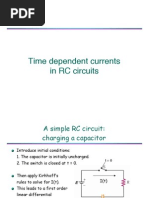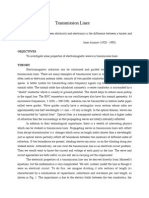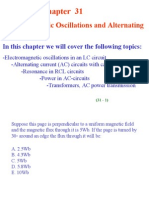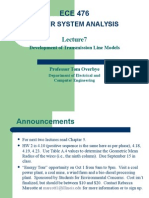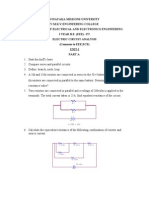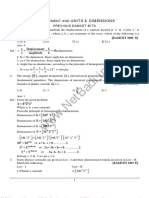Java For Web
Uploaded by
mit111Java For Web
Uploaded by
mit111CHAPTER 3 Working Of Memristor
3.1 Memristor Switching Mechanism
HP Labs memristor is a two terminal, two layer semiconductor built from layers of titanium dioxide sandwiched between two metal electrodes in a crossbar architecture. One layer of TiO2 is doped with oxygen vacancies, making it a semiconductor, while the adjacent layer is undoped, leaving it in its natural state as an insulator. The crossbar architecture is a fully connected mesh of perpendicular wires. Any two crossing wires are connected by a switch. To close the switch, a positive voltage is applied across the two wires to be connected. To open the switch, the voltage is reversed.
3.2 Working of Memristor
The memristor is composed of a thin (5 nm) titanium dioxide film between two electrodes as shown in figure 5(a) on the upcoming page. Initially, there are two layers to the film, one of which has a slight depletion of oxygen atoms. The oxygen vacancies act as charge carriers, meaning that the depleted layer has a much lower resistance than the non-depleted layer.
When an electric field is applied, the oxygen vacancies drift changing the boundary between the high-resistance and low-resistance layers. From the circuit-theoretic point of view, the three basic two-terminal circuit elements are defined in terms of a relationship between two of the four fundamental circuit variables, namely;the current i, the voltage v, the charge q, and the flux-linkage cp.Out of the six possible combinations of these four variables, five have led to well-known relationships . Two of these relationships are already given by 9 Q(t) = I (t) dt and O (t) = v(t) dt. . Three other relationships are given, respectively, by the axiomatic definition of the three classical circuit elements, namely, the resistor (defined by a relationship between v and i), the inductor (defined by a relationship between cp and i), and the capacitor defined by a relationship between q and v). Only one relationship remains undefined, the relationship between o and q. From the logical as well as axiomatic points of view, it is necessary for the sake of completeness to postulate the existence of a fourth basic twoterminal circuit element which is characterized by a o-q curve. This element will henceforth be called the memristor because, as will be shown later, it behaves somewhat like a nonlinear resistor with memory. The proposed symbol of a memristor and a hypothetical oq curve are shown in Fig. l(a). Using a ,mutated , a memristor with any prescribed o-q curve can be realized by connecting an appropriate nonlinear resistor, inductor, or capacitor across port 2 of an M-R mutated, an M-L mutated, and an M-C mutated, as shown in Fig. l(b), (c), and (d), respectively. These mutators, of which there are two types of each, are defined and characterized in Table I.3
Hence, a type-l M-R mutated would transform the VR -IR< curve of the nonlinear resistor f(VR, IR)=O into the corresponding o-q curve f(o,q)=O of a memristor. In contrast to this, a type-2 M-R mutated would transform the IR,VR curve of the nonlinear resistor f(IR,VR)=O into the corresponding o-q curve f(o,q) = 0 of a memristor. An analogous transformation is realized with an M-L mutated (M-C mutated) with respect to the ((oL,iL) or (iL, oL) [(vC, qC) or (qC, vC)] curve of a nonlinear inductor (capacitor).10 t Memristor and its o-q curve. Memristor basic realization o 1: M-R mutated terminated by nonlinear Resistor R. Memristor basic realization o 2: M-L mutated terminated by nonlinear inductor L Memristor basic realization M-C mutated terminated by nonlinear capacitor C
3.2.1 Mathematical Modeling
The memristor is essentially a two-terminal variable resistor, with resistance dependent upon the amount of charge q that has passed between the terminals. V=I.M(q) Where M can be defined in terms of differential equation as, M=dm/dQ
3.2.2 Memoristive system
The most basic mathematical definition of a current-controlled memristor for circuit analysis is the differential form v=R(w)i. dw/dt=i. where w is the state variable of the device and R is a generalized resistance that depends upon the internal state of the device. In this case the state variable is just the charge, but no one has been able to propose a physical model that satisfies these simple equations. In 1976 Chua and Kang generalized the memristor concept to a much broader class of nonlinear dynamical systems they called memristive systems, described by the equations v=R(w, i)i. dw/dt=f(w, i). where w can be a set of state variables and R and f can in general be explicit functions of time.
3.2.3 Circuit Theoratic Properties of Memorister
By definition memristor is a charge and flux controlled device. The voltage across a charge controlled memristor is given by v(t)=M(q(t))i(t). where, M(q)=d(q)/dq. Similarly current of a flux controlled memristor is given by i(t)=W(q(t))v(t). where, W(q)=dq()/d. Since M(q) has the unit of resistance, it will henceforth be called the incremental memristance. On the basis of his studies of memristor Chua proposed some theorems:a) Passivity Criterion :A memristor characterized by a differentiable charge controlled -q curve is passive if, and only if, its incremental memristance M(q) is nonnegative; i.e., M(q)0. b) Closure Theorem: A one-port containing only memristors is equivalent to a memristor. c) Existence and Uniqueness Theorems: Any network containing only memristors with positive incremental memristances has one, and only one, solution. d) Principle of Stationary Action (Coaction): A vector q is a solution of a network N containing only charge-controlled (flux-controlled) memristors if, and only if, it is a stationary point of the total action associated with. e) Order of Complexity: Let N be a network containing resistors, inductors, capacitors, memristors, independent voltage sources, and independent current sources. Then the order of complexity m of N is given by m=(bL+bC+bM) (nM+nCE+nLM) (nM+nLJ+nCM) where bL is the total number of inductors; bc is the total number of capacitors; bM is the total number of memristors; nM is the number of independent loops containing only memristors; nCE is the number of independent loops containing only capacitors and voltage sources; nLM is the number of independent loops containing only inductors and memristors; nM is the number of independent cut sets containing only memristors; nLJ is the number of independent cut sets containing only inductors and current sources; nCM is the number of independent cut sets containing only capacitors and memristors. Chua proved his proposed theorems by mathematical mean but till now it is not demonstrated practically.
3.2.4 Physical restrictions
M(q) is physically restricted to be positive for all values of q (assuming the device is passive and does not become superconductive at some q). A negative value would mean that it would perpetually supply energy when operated with alternating current. An applied constant voltage potential results in uniformly increasing m. It is not realistic for the function M(q) to contain an infinite amount of information over this infinite range. Three alternatives avoid this physical impossibility:
M(q) approaches zero, such that m = M(q)dq = M(q(t))I(t) dt remains bounded, but continues changing at an ever-decreasing rate. M(q) is periodic, so that M(q) = M(q q) for all q and some q, e.g. sin2(q/Q). The device enters hysteresis once a certain amount of charge has passed through, or otherwise ceases to act as a memristor.
You might also like
- MaxxForce DT, 9, 10 Diesel Engine Workshop Repair & Service Manual - SAMPLE PDF38% (34)MaxxForce DT, 9, 10 Diesel Engine Workshop Repair & Service Manual - SAMPLE PDF20 pages
- Drone Commercial pt107 Study Certification100% (2)Drone Commercial pt107 Study Certification13 pages
- The Elusive Memristor: Properties of Basic Electrical CircuitsNo ratings yetThe Elusive Memristor: Properties of Basic Electrical Circuits24 pages
- Design of Hspice Model For Dual-Doped Memristor: Electronics and Communication EngineeringNo ratings yetDesign of Hspice Model For Dual-Doped Memristor: Electronics and Communication Engineering6 pages
- A Capacitor Paradox: Joseph Henry Laboratories, Princeton University, Princeton, NJ 08544No ratings yetA Capacitor Paradox: Joseph Henry Laboratories, Princeton University, Princeton, NJ 085445 pages
- Design of Memristor: A Paper Presentation OnNo ratings yetDesign of Memristor: A Paper Presentation On12 pages
- Transmission-Line Modeling and Sensitivity Evaluation For - Lumped Network Simulation and Design in The Time DomainNo ratings yetTransmission-Line Modeling and Sensitivity Evaluation For - Lumped Network Simulation and Design in The Time Domain18 pages
- Antoniou Realisation of Gyratqrs Using Operational AmplifiersNo ratings yetAntoniou Realisation of Gyratqrs Using Operational Amplifiers13 pages
- Currents Through Inductances, Capacitances and ResistancesNo ratings yetCurrents Through Inductances, Capacitances and Resistances14 pages
- EES4400 L1 TL Smith Chart Network Parameters 2023 4No ratings yetEES4400 L1 TL Smith Chart Network Parameters 2023 466 pages
- A Capacitor Paradox: Joseph Henry Laboratories, Princeton University, Princeton, NJ 08544No ratings yetA Capacitor Paradox: Joseph Henry Laboratories, Princeton University, Princeton, NJ 085445 pages
- Dept. of Electronics and Communication Engineering: Sem / Year: Ii / INo ratings yetDept. of Electronics and Communication Engineering: Sem / Year: Ii / I41 pages
- Current Electricity: K.V. Raghunadh Vice Chairman Narayana Educational Institutions HyderabadNo ratings yetCurrent Electricity: K.V. Raghunadh Vice Chairman Narayana Educational Institutions Hyderabad11 pages
- Power System Analysis: Development of Transmission Line Models Tom Overbye and Ross BaldickNo ratings yetPower System Analysis: Development of Transmission Line Models Tom Overbye and Ross Baldick29 pages
- A Discussion of An Analytical Per-Unit-Length Impedance Matrix ModelNo ratings yetA Discussion of An Analytical Per-Unit-Length Impedance Matrix Model4 pages
- FEE MODEL QUESTION PAPER - SET 2 ANSWERSNo ratings yetFEE MODEL QUESTION PAPER - SET 2 ANSWERS14 pages
- Electromagnetic Oscillations and Alternating Current: in This Chapter We Will Cover The Following TopicsNo ratings yetElectromagnetic Oscillations and Alternating Current: in This Chapter We Will Cover The Following Topics31 pages
- Power System Analysis: Development of Transmission Line ModelsNo ratings yetPower System Analysis: Development of Transmission Line Models40 pages
- Power System Analysis: Development of Transmission Line Models Tom Overbye and Ross BaldickNo ratings yetPower System Analysis: Development of Transmission Line Models Tom Overbye and Ross Baldick29 pages
- Ch1 Current Volt Relationship Trasmission LineNo ratings yetCh1 Current Volt Relationship Trasmission Line84 pages
- Feynman Lectures Simplified 2C: Electromagnetism: in Relativity & in Dense MatterFrom EverandFeynman Lectures Simplified 2C: Electromagnetism: in Relativity & in Dense MatterNo ratings yet
- List of Abbreviations Airworthiness Regulations 2018100% (1)List of Abbreviations Airworthiness Regulations 201814 pages
- Cadillac Escalade 2003 - 2004 Fuse Box DiagramNo ratings yetCadillac Escalade 2003 - 2004 Fuse Box Diagram5 pages
- Consumer Reports New Cars - December 2022 USA100% (4)Consumer Reports New Cars - December 2022 USA204 pages
- What Does The BCM Control - 1999-2006 + 2007-2013 Chevrolet0% (2)What Does The BCM Control - 1999-2006 + 2007-2013 Chevrolet6 pages
- GM Vehicle Theft Deterrent Relearn Procedures100% (1)GM Vehicle Theft Deterrent Relearn Procedures4 pages
- BD Torqueshift 6: Download The Latest Install Manuals atNo ratings yetBD Torqueshift 6: Download The Latest Install Manuals at17 pages
- Midterm Examination: Fundamentals of MathematicsNo ratings yetMidterm Examination: Fundamentals of Mathematics6 pages
- Quine: Perspectives On Logic, Science and Philosophy: Interview by Bradley Edmister and Michael OjsheaNo ratings yetQuine: Perspectives On Logic, Science and Philosophy: Interview by Bradley Edmister and Michael Ojshea11 pages
- 3 Phase Inverter Controll Using PXS20 PDFNo ratings yet3 Phase Inverter Controll Using PXS20 PDF23 pages
- ENME 332, Spring 2013 Transfer Processes: Instructors: Reinhard Radermacher & Bao YangNo ratings yetENME 332, Spring 2013 Transfer Processes: Instructors: Reinhard Radermacher & Bao Yang18 pages
- Mechanics of Deformable Bodies Module 2No ratings yetMechanics of Deformable Bodies Module 219 pages
- 1 1 1 Tan Tan Tan 1 2 1 2 3 1 3 4 + + + + + + 1 ...... Tan 1 1 + + + Sin Cos 1 Sin +No ratings yet1 1 1 Tan Tan Tan 1 2 1 2 3 1 3 4 + + + + + + 1 ...... Tan 1 1 + + + Sin Cos 1 Sin +10 pages
- Purpose Return Value Syntax: The SUMIF FunctionNo ratings yetPurpose Return Value Syntax: The SUMIF Function5 pages
- Mathematical Foundation: CSE 6331 Algorithms Steve LaiNo ratings yetMathematical Foundation: CSE 6331 Algorithms Steve Lai23 pages
- FEMSSISA-Grade-7-Mathematics-Olympiads-2024No ratings yetFEMSSISA-Grade-7-Mathematics-Olympiads-20246 pages
- Determine Suitability of Database FunctionalityNo ratings yetDetermine Suitability of Database Functionality9 pages
- Commissioning Generator AVR, PSS and Model Validation: Wenyan Gu, Member, IEEENo ratings yetCommissioning Generator AVR, PSS and Model Validation: Wenyan Gu, Member, IEEE5 pages
- Using GW-BASIC For Drawing Mandelbrot SetsNo ratings yetUsing GW-BASIC For Drawing Mandelbrot Sets3 pages
- Learner Guide For Cambridge IGCSE Physics 0972No ratings yetLearner Guide For Cambridge IGCSE Physics 097248 pages
- Applied Acoustics: Masoud Golzari, Ali Asghar JafariNo ratings yetApplied Acoustics: Masoud Golzari, Ali Asghar Jafari22 pages
- MaxxForce DT, 9, 10 Diesel Engine Workshop Repair & Service Manual - SAMPLE PDFMaxxForce DT, 9, 10 Diesel Engine Workshop Repair & Service Manual - SAMPLE PDF
- The Elusive Memristor: Properties of Basic Electrical CircuitsThe Elusive Memristor: Properties of Basic Electrical Circuits
- Design of Hspice Model For Dual-Doped Memristor: Electronics and Communication EngineeringDesign of Hspice Model For Dual-Doped Memristor: Electronics and Communication Engineering
- A Capacitor Paradox: Joseph Henry Laboratories, Princeton University, Princeton, NJ 08544A Capacitor Paradox: Joseph Henry Laboratories, Princeton University, Princeton, NJ 08544
- Transmission-Line Modeling and Sensitivity Evaluation For - Lumped Network Simulation and Design in The Time DomainTransmission-Line Modeling and Sensitivity Evaluation For - Lumped Network Simulation and Design in The Time Domain
- Antoniou Realisation of Gyratqrs Using Operational AmplifiersAntoniou Realisation of Gyratqrs Using Operational Amplifiers
- Currents Through Inductances, Capacitances and ResistancesCurrents Through Inductances, Capacitances and Resistances
- EES4400 L1 TL Smith Chart Network Parameters 2023 4EES4400 L1 TL Smith Chart Network Parameters 2023 4
- A Capacitor Paradox: Joseph Henry Laboratories, Princeton University, Princeton, NJ 08544A Capacitor Paradox: Joseph Henry Laboratories, Princeton University, Princeton, NJ 08544
- Dept. of Electronics and Communication Engineering: Sem / Year: Ii / IDept. of Electronics and Communication Engineering: Sem / Year: Ii / I
- Current Electricity: K.V. Raghunadh Vice Chairman Narayana Educational Institutions HyderabadCurrent Electricity: K.V. Raghunadh Vice Chairman Narayana Educational Institutions Hyderabad
- Power System Analysis: Development of Transmission Line Models Tom Overbye and Ross BaldickPower System Analysis: Development of Transmission Line Models Tom Overbye and Ross Baldick
- A Discussion of An Analytical Per-Unit-Length Impedance Matrix ModelA Discussion of An Analytical Per-Unit-Length Impedance Matrix Model
- Electromagnetic Oscillations and Alternating Current: in This Chapter We Will Cover The Following TopicsElectromagnetic Oscillations and Alternating Current: in This Chapter We Will Cover The Following Topics
- Power System Analysis: Development of Transmission Line ModelsPower System Analysis: Development of Transmission Line Models
- Power System Analysis: Development of Transmission Line Models Tom Overbye and Ross BaldickPower System Analysis: Development of Transmission Line Models Tom Overbye and Ross Baldick
- Feynman Lectures Simplified 2C: Electromagnetism: in Relativity & in Dense MatterFrom EverandFeynman Lectures Simplified 2C: Electromagnetism: in Relativity & in Dense Matter
- List of Abbreviations Airworthiness Regulations 2018List of Abbreviations Airworthiness Regulations 2018
- What Does The BCM Control - 1999-2006 + 2007-2013 ChevroletWhat Does The BCM Control - 1999-2006 + 2007-2013 Chevrolet
- BD Torqueshift 6: Download The Latest Install Manuals atBD Torqueshift 6: Download The Latest Install Manuals at
- Quine: Perspectives On Logic, Science and Philosophy: Interview by Bradley Edmister and Michael OjsheaQuine: Perspectives On Logic, Science and Philosophy: Interview by Bradley Edmister and Michael Ojshea
- ENME 332, Spring 2013 Transfer Processes: Instructors: Reinhard Radermacher & Bao YangENME 332, Spring 2013 Transfer Processes: Instructors: Reinhard Radermacher & Bao Yang
- 1 1 1 Tan Tan Tan 1 2 1 2 3 1 3 4 + + + + + + 1 ...... Tan 1 1 + + + Sin Cos 1 Sin +1 1 1 Tan Tan Tan 1 2 1 2 3 1 3 4 + + + + + + 1 ...... Tan 1 1 + + + Sin Cos 1 Sin +
- Mathematical Foundation: CSE 6331 Algorithms Steve LaiMathematical Foundation: CSE 6331 Algorithms Steve Lai
- Commissioning Generator AVR, PSS and Model Validation: Wenyan Gu, Member, IEEECommissioning Generator AVR, PSS and Model Validation: Wenyan Gu, Member, IEEE
- Applied Acoustics: Masoud Golzari, Ali Asghar JafariApplied Acoustics: Masoud Golzari, Ali Asghar Jafari

























